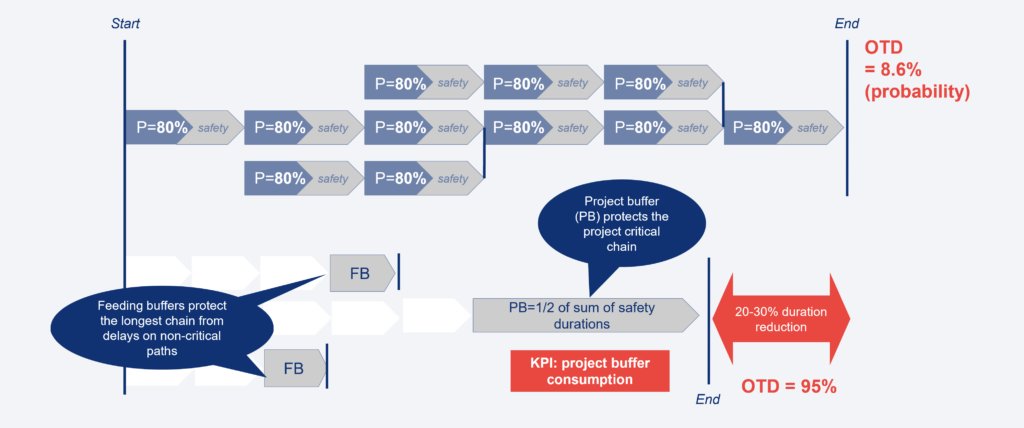Project management often encounters challenges related to meeting deadlines, limited resources, and uncertainties in planning. In light of this complexity, we need to adopt innovative and efficient strategies that can optimize workflow and ensure the successful delivery of projects.
This article explores the power of the Critical Chain model in project management. The Critical Chain approach goes beyond conventional methodologies, offering a more holistic and results-oriented vision. By focusing not only on the sequence of individual tasks but also on the constraints that directly impact the completion of the project, the Critical Chain aims to maximize efficiency, reduce variability, and ensure that resources are available when needed.
What are the benefits of Critical Chain?
Implementing the Critical Chain in project management offers benefits significantly contributing to the project’s overall success.
Predictability in Project Completion
Efficient buffer management and identifying critical activities promote a more predictable conclusion, reducing last-minute surprises.
Focus on High-Impact Activities
The Critical Chain directs attention to critical activities, avoiding distractions and ensuring that resources are allocated where they are most needed.
Improvement in Communication and Collaboration
The transparency provided by the Critical Chain, including buffer monitoring, promotes more effective communication and collaboration among team members and stakeholders.
Proactive Risk Management
Continuous analysis of buffers and rigorous project tracking allow for early detection of potential problems, enabling corrective actions before they impact the schedule.
Overall Project Efficiency
By avoiding multitasking, eliminating constraints, and optimizing resource use, the Critical Chain contributes to a more efficient execution of the project as a whole, reducing its total duration.
This methodology applies to various projects, from product development projects to significant capital investment projects, such as new factories, logistics centers, production lines, etc.
Understanding the Critical Chain and its Foundations
The Critical Chain, presented by Eliyahu M. Goldratt in 1997 in the book “Critical Chain,” is a sequence of activities that determines the project’s total duration, considering task dependencies and resources. Unlike traditional methods, such as the Critical Path Method and PERT, the Critical Chain Method (CCM) stands out for its emphasis on resource availability and leveling based on the theory of constraints.

Critical Chain Identification and Buffer Management
Constraints that can prevent the project from being completed within the defined timeframe include uncertainty in each task and increased duration estimates due to safety margins. The Critical Chain is identified after creating the project schedule and determining the critical path. The initial critical path is then reassessed based on the Critical Chain Method.
Unlike the Critical Path Method, which uses slack, the Critical Chain Method uses buffers. These buffers are added at the end of the task chain, considering resource availability and dependencies along the task chain. There are three types of buffers:
- Project Buffer: Placed between the last task and the project’s end date. It acts as a contingency to prevent delays in the Critical Chain.
- Feeding Buffer: Placed at the end of non-critical chains to synchronize their durations with the Critical Chain. Delays in these chains do not affect the Critical Chain.
- Resource Buffer: Placed before a critical task that requires essential resources.

Efficient management of these buffers is crucial to control the project schedule. The Critical Chain Method focuses on managing these buffers to control the same effectively.
Critical Chain vs. Critical Path
Although the definition of Critical Chain is similar to Critical Path in traditional project management, the approaches differ significantly. The Critical Path Method determines the path by mathematical calculations, with slack added to each activity. In the Critical Chain Method, activity durations are estimated with the minimum necessary time, and a project buffer is added at the end of the project as a contingency.
While the Critical Path considers only task sequences, the Critical Chain Method considers task and resource dependencies.
Moreover, CCM uses buffers, providing more efficient and aggressive scheduling, focusing on managing these buffers to help ensure the project schedule. In contrast, the Critical Path seeks to control project performance through activity monitoring.
Why Do Tasks Take Longer Than Necessary?
Tasks often take more time than strictly necessary, which can be attributed to four behavior patterns influencing project time management.

Behavior Pattern 1: Safety at the Task Level
Often, time estimates are inflated by a safety mentality. People think the task will take longer for safety. This practice aims to ensure that the task is completed on time, but the additional margin can vary depending on the optimism or pessimism of the person involved.
“I think this task will take five days, but I will consider eight days to ensure I finish on time.”
Behavior Pattern 2: Parkinson’s Law
Parkinson’s Law manifests when an individual approaches a task and uses the remaining time to improve the work further. Instead of communicating the early completion, there is a natural inclination to keep perfecting the outcome until the last available moment.
“I’m almost done with my task, but since I still have time, I’ll use what is left to improve my work further.”
Behavior Pattern 3: Student Syndrome
This behavior arises when people procrastinate at the start of the task, believing they have plenty of time. This results in carrying out activities, sometimes unnecessary, before focusing on the main task, wasting the planned safety margin.
“Well… I have eight days, so I have time to do other activities. These are more interesting and also necessary.”
Behavior Pattern 4: Multitasking
The habit of performing multiple tasks simultaneously contributes significantly to expanding the time needed to complete each activity. Juggling between different tasks consumes time and increases complexity and, consequently, the total task duration.
“I don’t have time for everything! I must keep ‘jumping’ from task to task to get them all moving forward…”
Understanding these behavior patterns is vital for implementing effective time management strategies and ensuring that tasks are completed within the established deadlines, minimizing the effects of these behavior patterns.
Step-by-Step Implementation Guide
Successfully implementing the Critical Chain in project management requires a structured and careful approach. Below is a step-by-step guide detailing the essential steps for effectively implementing the Critical Chain.
1. Identify Critical Chain and Task Safety
The first step involves identifying the Critical Chain, the sequence of activities that establishes the project’s total duration, considering both task and resource dependencies.
Analyze and understand the presence of safety in time estimates for each task. Identify behavior patterns, such as the tendency to allocate additional time as a precaution.
2. Correct: Remove Task Safety and Place Safety in the Project Buffer
Adjust the time estimates, removing excessive safety attributed to tasks. Realistic estimates are essential for the effectiveness of the Critical Chain. Estimate task durations at the 80% level (80% compliance probability) – the natural human tendency for task time estimation with safety. Estimate task durations at the 50% level (50% compliance probability) – assuming that half of the tasks will be completed on time and the other half will be delayed. Half of the difference between these two values is the buffer.
Reposition the safety margin removed from tasks in the project buffer. This buffer acts as a strategic backup to deal with any delays, keeping the focus on the realistic task duration. This is the project buffer.
3. Define: Project Buffer as the Main Indicator and Feeding Buffer for Non-Critical Tasks
Establish the project buffer as the leading project performance indicator. Closely monitor this buffer’s consumption to assess the project’s overall health.
Implement feeding buffers at the end of non-critical chains to synchronize them with the Critical Chain. These buffers protect the Critical Chain from potential delays in non-essential activities.
4. Safeguard: Avoid Multitasking, Eliminate Constraints, and Set Resource Buffers
Encourage a focused approach, discouraging multitasking. Concentrating on individual tasks reduces complexity and improves the project’s overall efficiency.
Identify and eliminate any constraints that may prevent the efficient flow of work. Removing obstacles is essential for optimizing task execution.
Establish resource buffers before critical tasks that require essential resources, such as labor or equipment. These help ensure resource availability for task completion.
5. Control: Buffer Consumption
Closely monitor the consumption of the project buffer throughout the project. Regular tracking allows proactive adjustments to keep the project on track.
Control the consumption of resources and feeding buffers to ensure that non-critical activities do not adversely affect the Critical Chain. Careful management of these elements contributes to the overall success of the project.

Without slack in individual tasks, resources are encouraged to focus on the task at hand to complete it and pass it on to the next person or group. Here, the goal is to eliminate the harmful practice of multitasking by prioritizing all resources. Each element of the project is encouraged to move as quickly as possible. When performing their “step” of the project, they should focus on completing the assigned task as soon as possible, minimizing distractions and multitasking.
Here, the goal is to avoid procrastination or unnecessary extra work when there seems to be time left. This contrasts with traditional project management, which monitors tasks’ start and end. MCC encourages people to move as quickly as possible, regardless of dates.
As task duration was planned based on a 50% probability, there is pressure on resources to complete critical chain tasks as quickly as possible, overcoming the previously mentioned Student Syndrome and Parkinson’s Law.
Conclusion
Implementing a Critical Chain in project management is a transformative approach, offering a range of advantages that significantly contribute to the project’s overall success. By improving the Critical Path Method and PERT, Critical Chain stands out for its emphasis on efficient resource management, proactive identification of constraints, and innovative time management strategies.
Looking ahead, Critical Chain is an innovative approach that will continue to shape the project management landscape. As organizations seek more agile and effective methods, the emphasis on resource management, constraint identification, and schedule predictability becomes increasingly crucial. With its unique approach and focus on overall efficiency, Critical Chain is well-positioned to play a central role in the ongoing evolution of project management practices.
Still have questions about Critical Chain Planning?
What is PERT?
PERT (Program Evaluation Review Technique) is a project management practice developed to handle the uncertainty associated with the completion times of tasks/activities. It was introduced in the late 1950s to support complex projects, especially those related to research and development. PERT uses three-time estimates for each project activity: optimistic, pessimistic, and most likely. Based on these estimates, a weighted estimate is calculated, which is used to establish the expected activity duration. The PERT method also considers the variation of these estimates to calculate a safety margin and assist in project management, especially when there is uncertainty in the activities’ duration.
What is a Buffer?
In the Critical Chain and project management context, a buffer refers to a strategically inserted time reserve in the project schedule to accommodate uncertainties and variations. It is a fundamental technique for managing variability in activity durations and ensuring the project is completed on time, even in the face of potential delays. There are several types of buffers used in Critical Chain:
- Project Buffer: Placed at the end of the project, between the last critical task and the project’s completion. It acts as a contingency to protect against delays in the critical path.
- Feeding Buffer: Placed at the end of non-critical chains to synchronize their durations with the Critical Chain. If there are delays in these chains, the feeding buffer prevents them from affecting the Critical Chain.
- Resource Buffer: Placed before a critical task that requires essential resources, such as labor or equipment. It ensures the availability of these resources when needed for task completion.
Buffers are actively managed during project execution, and their consumption is monitored to ensure proactive actions and guarantee that the project is delivered within established deadlines.
See more on Lean Product Development
Find out more about improving this business area
